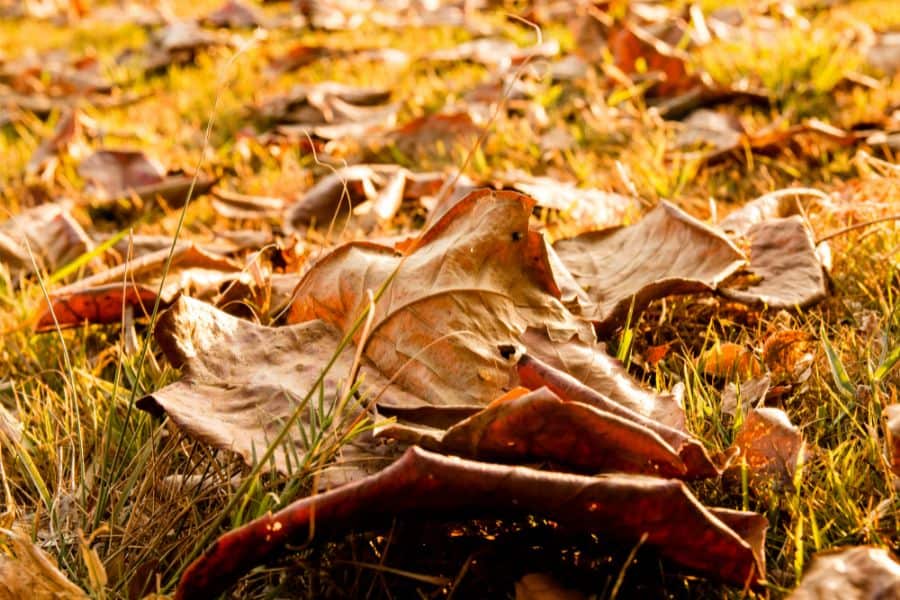Aside from its biological function, we place plants in our aquarium to add greenery and increase its aesthetic beauty. We often choose to keep healthy and vibrantly colored plants that make our fish happy, even if they live in a confined space.
But this is not always the case. I have seen many set-ups with dried leaves, and their dull brown coloration doesn’t match what an aquarium should look like.
Dried dead leaves and not live aquarium plants? Yes, like the Indian Almond Leaves.
But why?
Join us in this article and learn why adding dried Indian Almond Leaves is not just about creating natural aesthetics but also contributes to tank maintenance and fish care.
What Are Indian Almond Leaves?
Also known as Catappa Leaves, the dried Indian Almond Leaves used in the aquarium hobby come from the Catappa tree (Terminalia catappa).
Native to Asia, this large tropical tree has a wide range of human use. The fruits are edible, its water-resistant redwood is ideal for making boats, and the cool shade its canopy provides makes them great ornamental trees.
What is so special about this tree is its leaves. Having powerful antioxidants, Indian Almond Leaves are used in traditional medicine to treat diarrhea, liver diseases, and cancer.
And the good news is that each Catappa tree has thousands of leaves, and many will wither, drop to the ground, and can be used for other purposes, like in our aquarium hobby.
Active Organic Compounds
Indian Almond Leaves contain organic compounds that have antifungal, antiviral, and antibacterial properties, like:
Tannins
Also called Tannic acid, tannins are commonly occurring in most fruit-bearing trees. They are a type of astringent that gives a fruit a pungent taste, making it unpleasant and deterring animals from eating them. The concentration of tannins is high when the fruit is young and decreases as it ripens.
For the Catappa tree, tannins are not just found in fruits, but their leaves are also enriched with this type of acid.
The fact is, 13% of its leaf mass is composed of tannins. And it is not just about the percentage, but the concentration of tannins in Indian Almond Leaves is so high that it can kill viruses, fungi, and bacteria.
Quercetin
Flavonoids are antiviral compounds commonly found in plants and used to defend against plaque. In the Indian Almond Leaves, it contains high amounts of quercetin flavonoid which is also an antioxidant that can heal tissue damage.
How to Use Indian Almond Leaves
If you’re lucky to have a Catappa tree nearby, collect their fallen leaves. Be aware that some fallen leaves are fresh (usually colored green or red), and you should dry them for days until they turn brown.
When there’s no Catappa tree nearby, or you want to skip the drying process, you can purchase dried Indian Almond Leaves online.
For aquarium application, we need dried leaves and not fresh ones. Tannins, quercetin flavonoids, and other compounds will only come out of the leaves when they decompose and break down while soaking them in the water.
Important reminder: Filter media such as activated carbon will absorb the compounds released by your Indian Almond Leaves. Remove them before you place the dried leaves in your tank.
Direct Application
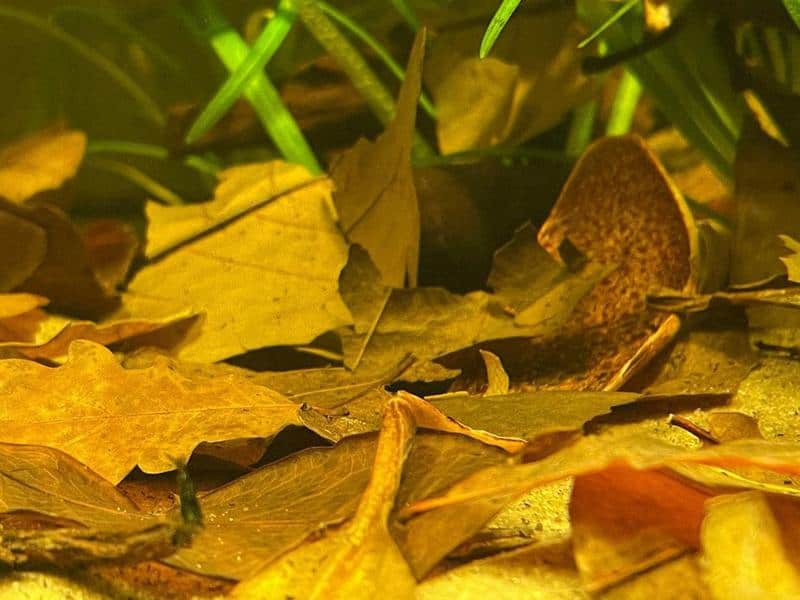
The easiest way to use Indian Almond Leaves is to apply and soak them directly in your tank.
Once you place the dried leaves in the water, they will initially float and slowly sink as the hour’s pass. Depending on the water depth of your tank, it usually takes a day before the leaves settle at the bottom.
While soaked in the water, decomposition speeds up, and the compounds are released. A clear indication that the compounds are released is the discoloration of your water (usually from yellow to light brown).
The color of your water will also give you an indication as to how concentrated the compounds are. Yellow means low, while light brown to brown means high concentration.
You can control the concentration of compounds by following the recommended one dried leaf for every 10 gallons of water. If you have a smaller tank, you can cut the leaves into half or smaller, depending on how small your tank is.
The potency of the compounds can last for up to a month. After which, you can remove the remains and add a new set of dried leaves.
Making an Extract
Rotting leaves in a tank are not aesthetically pleasing to see. But you can still add the compounds from Indian Almond Leaves by making an extract.
You can do this by placing a single dried leaf in a bowl and adding 2 liters of warm water. Be cautious not to use boiling water since it reduces the potency.
Leave it for 24 hours, and afterwards, you will see the water turning into brown, which is the concentrated extract from the leaves. Store the extract in a sealed container, label it properly and place it in the fridge for a longer shelf life that can last up to 6 months.
When the time comes you need to apply the extract, just pour it over the tank. Do not pour all the contents at once and follow the recommended dosage which is 30 ml extract for every gallon of water.
Advantage of Extract Over Direct Application
In the direct application process, you just put the dried leaves and allow the release of compounds. However, compounds are constantly released during the entire duration while the leaves are decomposing. It means that the concentration increases over time.
With the absence of decomposing leaves in the extract, the concentration will depend on how much extract you pour in. In other words, you have direct control.
Primary Benefits
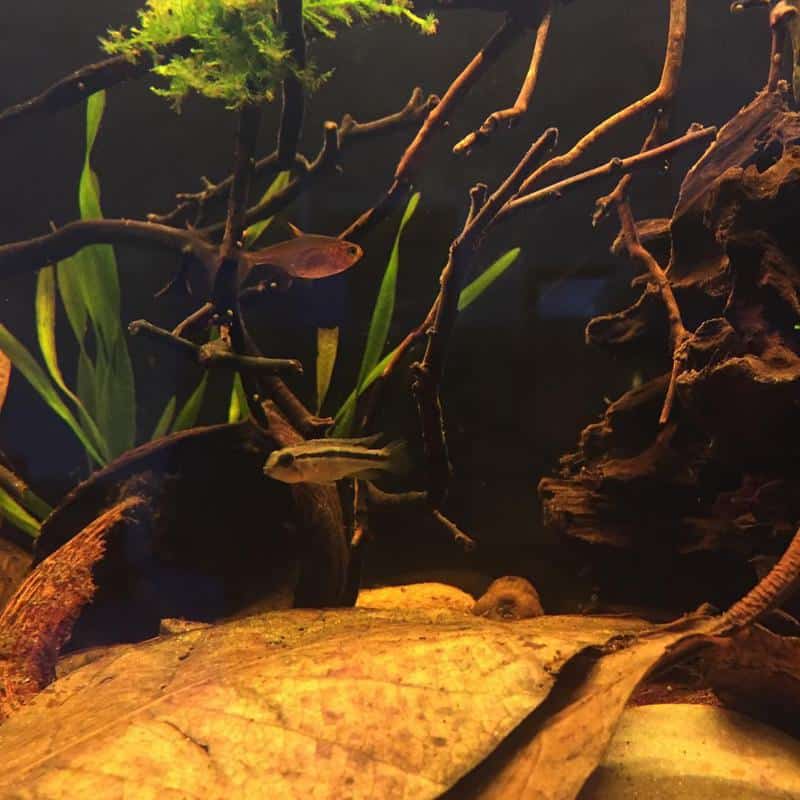
So why add Indian Almond Leaves to your tank and discolor your once crystal-clear water? The answer is simple: the benefits outweigh the decreased aesthetics.
Here are the primary benefits of adding Indian Almond Leaves to your tank:
Improve Water Quality
Tannins from Indian Almond Leaves directly influence water parameters by lowering the pH and gH.
But how? Many articles have failed to explain this and we are lucky to talk to a chemist and here’s the scientific explanation.
When tannins are released and dissolved in the water, they give off positive molecules that bind with hydrogen that is already existing in the water.
Remember the H from H20? In effect, the binding of tannin and hydrogen creates hydronium (H3O+), the ion mainly dictating the pH level of your water. The more hydronium, the lower your water pH will be.
Aside from hydrogen, tannins will also bind to other molecules, particularly calcium and magnesium. These molecules are the influencers of water hardness (gH). Since they are already bonded to tannins, they can no longer influence water hardness, thus lowering your gH.
But be careful and do not be deceived by tannins and their pH and gH-lowering traits. Some newbies have placed more dried Indian Almond Leaves making their tank water acidic and too soft for most fish to survive. Only apply the recommended amount of dried Indian Almond Leaves.
Also, do not apply dried Indian Almond Leaves when your pH and gH levels are stable. By doing so, you will make your water more acidic and more softer.
Heals Skin-related Illnesses
Tannins from Indian Almond Leaves have antibacterial, antifungal, and antiviral properties. But when it comes to its healing properties, we should emphasize the anti-inflammatory flavonoid quercetin which is naturally occurring in large quantities within Indian Almond Leaves.
Combining the effects of tannins and the flavonoid quercetin allows an injured fish to heal faster. The fact is, many aquarists have considered Indian Almond Leaves to be better than most antibiotics and other forms of synthetic medication.
Indian Almond Leaves and Betta Fish
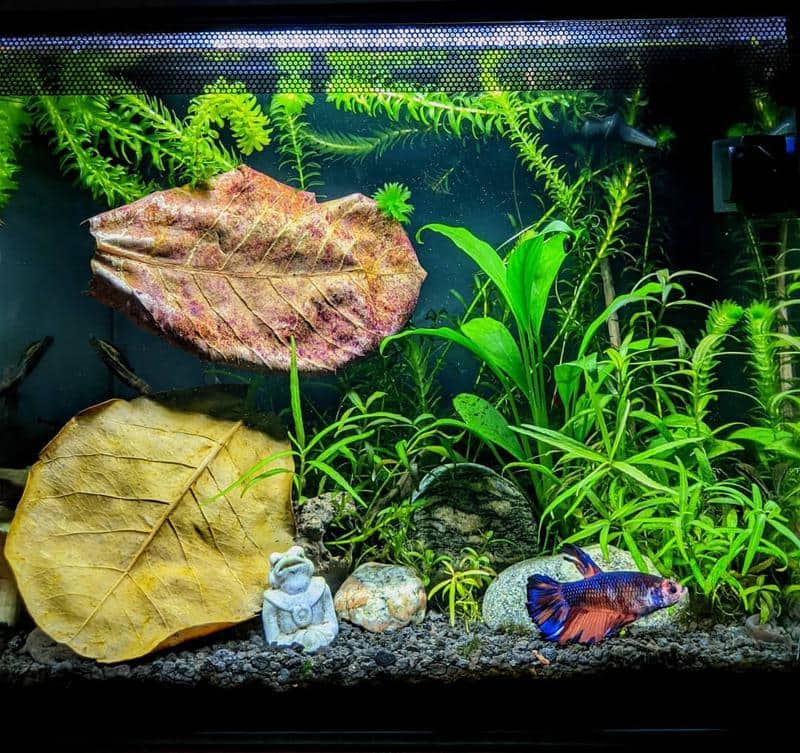
Although considered animal cruelty, fish fighting is still practiced today, especially in Southeast Asia using Betta Fish.
Skin injuries are the least a Betta Fish can suffer from a fight and most of them succumb if not treated. It is why most Betta Fish are quarantined in a tank infused with Indian Almond Leaves.
Over the time, breeders have also found out that Betta Fish skin becomes tougher with prolonged exposure to Indian Almond Leaves. It is why most breeders soak their specially-bred Betta Fish where their toughened skin gives them higher chances of winning.
Axolotl and Why they need Indian Almond Leaves
This type of salamander is one of the popular amphibians kept in an aquarium. However, their skin is smooth, slimy and lacks scales for protection, exposing them to frequent bacterial and fungal infection.
Another thing with Axolotls is their poor immune system that is further reduced when exposed to stressors like poor water quality.
With occasional exposure to Indian Almond Leaves, the skin of your Axolotl will be free from infection and the improved water quality from the dried leaves will also contribute to a better immune system.
Secondary Benefits
When you choose the direct application (not the extract), the dried Indian Almond Leaves will provide secondary benefits that will be enjoyed particularly by your tank residents, like:
Food for Shrimps and Tiny Fish
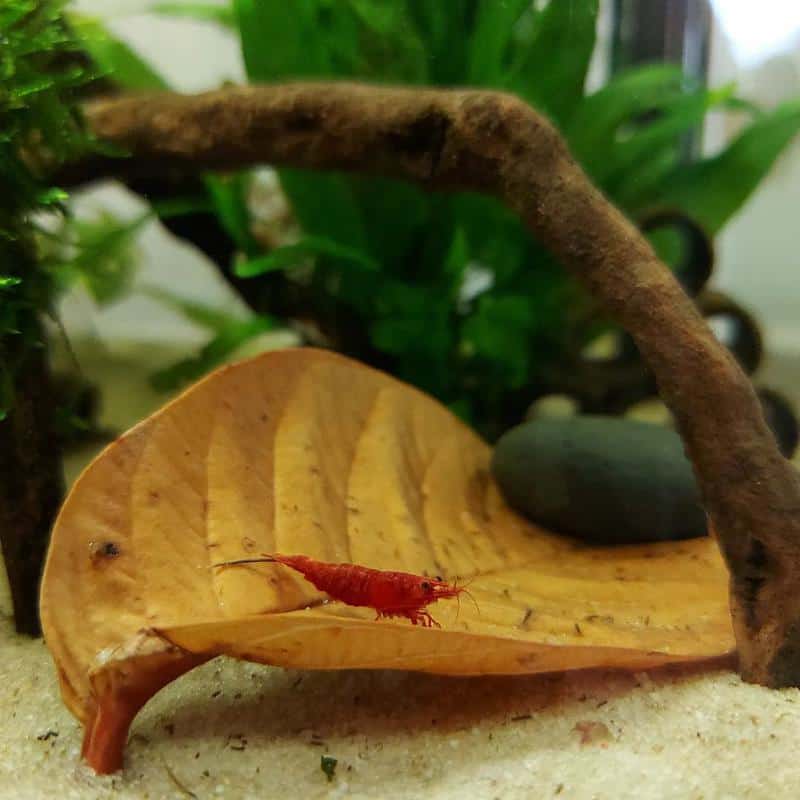
Shrimps love Indian Almond Leaves. The moment it sinks and settles at the bottom, shrimps will start swarming to feast on their degraded leaves.
Aside from shrimps loving the taste of Indian Almond Leaves, the microorganisms that grow while they degrade will also attract other small fish to dine on the leaf waste.
Caution: Not all shrimps are compatible with Indian Almond Leaves. Some examples are the Cardinal Shrimp (Caridina dennerli) and the Crystal Red Shrimp (Caridina cantonensis) since they require higher pH and gH.
Leaf Litter-Inspired Aesthetics
While a greenery-inspired tank is common and what we usually see, it is not always the case. With the Indian Almond Leaves, the degrading leaves will create a leaf litter effect that closely represents its natural environment.
Remember that in wild freshwater habitats, water clarity is not always crystal, and the substrate is not tidily clean. Rather, water is usually murky and the substrate is filled with rotting leaves, tree branches and other degrading matter.
Although it is not aesthetically pleasing to see, what it represents is the real situation.
Driftwood and Other Alternatives
Driftwoods are great alternatives to Indian Almond Leaves. Not only do they improve aesthetics, but they can also lower your water pH as they contain tannins. It is why your water will start to discolor when you place them in the tank.
Take note that the tannin content varies per type of driftwood. For the most concentration, we recommend the Cholla Cactus Wood for small tanks and the Sinkable Spider Wood for large tanks.
If you are in Asia, dried Banana Leaves are a great alternative. For our US or Europe readers, you can use the Alder Cones from the Black Alder Tree.
Read More:
FAQs
Which Fish Are Not Compatible with Indian Almond Leaves?
Any fish that require high pH and hard water are not compatible with the Indian Almond Leaves. Some examples are Cichlids, Guppies, Mollies, and Swordtails.
Why Choose Indian Almond Leaves Over Other Kinds of Leaves?
Setting aside how leaves lower pH and heal illnesses, what sets Indian Almond Leaves from other types of leaves is their tough and durable properties. Even if they are dried, their leaves are still thick, and their leaf veins are large, making the degrading process prolonged.
It means that Indian Almond Leaves emit tannins longer than any other leaves compared.
What Happens if I Use Too Many Indian Almond Leaves?
If you will not follow the recommended amount of dried leaves to place in a gallon of water, expect that your pH will decrease further making your tank water super acidic.
Aside from this, expect that water discoloration will become more intense as more tannins are released.
To counteract the effects, you can do a 25% water change to dilute the tannin concentration. After water change, you can add activated carbon to absorb the excess tannin and gradually increase your pH.
Can I Use Fresh Indian Almond Leaves to Lower Aquarium pH?
Yes, but it will take time to effect and is not recommended. Remember that tannins are only released when the leaves are degraded and you can only achieve this when the leaves are dried.
Final Thoughts
It is without a doubt that Indian Almond Leaves have water quality controlling agents and healing properties. And do not worry about water discoloration since it is only temporary. Your water quality and the welfare of your fish and other tank residents are more important than aesthetics.
And lastly, to be fully convinced of the healing properties of Indian Almond Leaves, why not sip a cup of hot tea while sitting in front of your tank and enjoying the natural leaf litter aesthetics.
